The United States’ fifth-largest air carrier ’“ Alaska Airlines ’“ traces its roots deep into American history; in fact, the airline began in its namesake’s state nearly 27 years before Alaska achieved statehood. The formerly localized west coast regional air carrier boasts an impressive route structure, serving 116 destinations with over 1,200 daily departures. After the 2016 acquisition of San Francisco-based Virgin America, Alaska Airlines began a new phase of operations, utilizing its inheritance of 67 Airbus aircraft and dozens of new routes. When mainline service is combined with wholly-owned subsidiary Horizon Air and contracted carrier SkyWest Airlines, Alaska Airlines proudly boats the honor of operating the ’œMost West Coast’ flights each day.
However, Alaska Airlines and its affiliates have carefully expanded their daily operations far beyond the western United States, serving eastern seaboard destinations from Boston to Ft. Lauderdale. In 2014, 25% of all Alaska Airlines daily departures traveled across North America; after the Virgin America acquisition a mere four years later, that figure has nearly doubled. Simultaneously, growth to areas outside of the continental U.S. remains relatively stable and, in some cases, diminished. After connecting Bellingham, Washington to various Hawaiian destinations for nearly a decade, Alaska Airlines announced cessation of all Bellingham nonstop flights except service to Seattle-Tacoma. Growth within the airline’s namesake state of Alaska remains stagnant; service to Mexico faces a similar outcome.
Alaska Airlines, alongside subsidiary Horizon Air and its partner SkyWest Airlines ’“ through a capacity purchase agreement ’“ has strategically eliminated under performing routes over the recent years. Instead, Alaska has elected to beef up its west coast hubs to maintain a stronghold among residents along the west coast. After the 2008 merger of Delta and Northwest, ferocious competition rose in former Alaska Airlines strongholds, specifically Seattle and Portland. Delta Air Lines maintains an expansive international network from Seattle, leading to recent growth and additions in domestic service and direct competition with Alaska Airlines. To combat, recent Alaska Airlines strategic decisions can be categorized into three distinct categories: Streamlined regional operations, acquisition of Virgin America, and an ever-expanding route network.
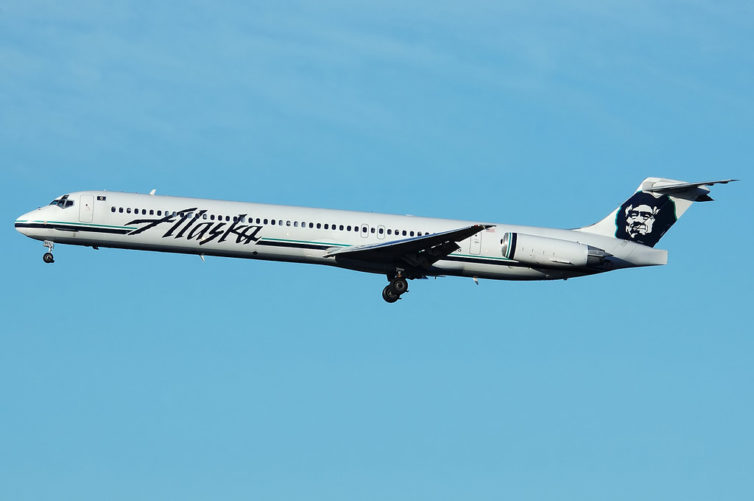
Alaska Airlines MD-83 – Photo: Andrew W Sieber | FlickrCC
Streamlined Regional Operations
To fully grasp the recent expansion of the former geographically condensed airline, one can consider Alaska Airlines’ route network from 1987, a time when MD80 and Boeing 727 series aircraft donned the iconic ’œChester’ tailfin logo. Service spanned the western United States in a vertical north-south manner; Chicago and Washington D.C. marked the airlines’ sole destinations east of the Mississippi river.
Horizon Air, then in its infancy stage, served various Northwest destinations using Fokker F27 and Fairchild Metroliner aircraft. An astonishing number of these former Horizon Air destinations ’“ 11, to be exact ’“ are no longer served by the carrier. The list of terminated destinations includes rural mountain communities such as Idaho Falls, Idaho, agriculture towns like Pendleton, Oregon, and the coastal city of Port Angeles, Washington.
As aircraft technology gave rise to regional jets and efficient turboprop aircraft like the Q400, Horizon Air began to deliberately shift service away from rural communities, instead opting to service more profitable, higher-capacity routes. The purchase of Bombardier CRJ700 series aircraft expanded regional connection possibilities; the regional network of Horizon Air quickly encompassed numerous routes spanning across multiple west coast states. Ultimately, after consolidating the Horizon Air brand into parent Alaska Airlines, the CRJ700-series aircraft slowly left the fleet; briefly, SkyWest operated some former Horizon Air CRJ700s for Alaska Airlines on longer, low-density routes.
With the advent of the Embraer E175-series aircraft, Horizon Air gained the ability to serve destinations far from their west coast hubs of Seattle and Portland. As a result, routes blossomed that were previously deemed too long for Q400 turboprop service, but lacking the demand for frequent mainline Alaska Air connectivity. The 76-seat E175 fills a unique niche market for expansion of the Alaska Air regional network; its jet engines allow for faster cruise speeds at higher altitudes, a greater range, and a more comfortable ride for passengers. Communities such a Bozeman, Reno, and Boise see multiple daily flights from Seattle on E175 aircraft, a service that was dominated by Q400s a few short years ago. However, perhaps more significant for Alaska Airlines, the E175 type allowed for the genesis of new services, stemming from its ability to carry light loads on relatively long flights. This unique ability led to new nonstop destinations added to the Alaska Air network from Seattle, including Milwaukee, Wichita, Oklahoma City and, most recently, El Paso.
BONUS: Giddy Up, Q400: Taking the Cowboy Boots Express to Montana
Despite possessing the same number of seats as the Q400, Alaska Air saw increased profit margins with E175 operations as reported in Alaska Air Group’s quarterly financial statements. In turn, Alaska Air continues to steadily retire the Q400 aircraft; a fleet size of 50 Q400s at the end of 2017 is projected to dwindle to only 23 by the conclusion of 2020. Conversely, Alaska Air continues to increase its operation of E175s; 62 of the type will sport the ’œChester’ logo by the end of 2020, split evenly between Horizon Air and through the capacity purchase agreement with SkyWest Airlines. Although the E175 is more profitable on some routes, the Q400 holds a unique niche market, servicing Alaska’s shortest routes, comprised largely of intrastate service.
The Horizon Air brand has greatly matured since its Pacific Northwest beginnings, but the Horizon charm and feel remains consistent with its original model. Select complimentary alcoholic beverages are still served on all Horizon operated flights, and its employees’ passion for service lives on today. Its network spans as far east as Missouri and north as Alberta; yet its Seattle roots continue to dominate the Pacific Northwest skies.

The special More to Love livery celebrates the merging of Virgin and Alaska – Photo: Jeremy Dwyer-Lindgren | JDLMultimedia
Alaska Acquires Virgin America
Beginning in the early 2000s, Alaska Airlines saw the greatest change to their route network. New destinations ’“ accessible through their predominately Boeing 737 fleet ’“ appeared on timetables; new services included destinations across the continental United States. Cities in the northeast, such as Boston and Newark were added. Northwest-based passengers heading to the warm climates of Orlando and Miami rejoiced as Alaska announced nonstop destinations to cities along the Atlantic Coast. In late 2007, Alaska began crossing the Pacific Ocean, expanding service to Honolulu from Seattle and Anchorage. Within the next few years, Alaska extended service to Hawaii beyond Oahu, adding Kahului on Maui and Kona on the Big Island.
By the early 2010s, Alaska served nearly all major United States leisure and business destinations from their Pacific Northwest hubs. However, the route map prior to the acquisition of Virgin America heavily favored destinations bordering the Pacific Ocean; many transcontinental services were operated on a once-daily schedule stemming from low passenger demand. Simultaneously, post-merger with Northwest, Delta began beefing up service to Seattle, elevating it to hub status in 2014. Continental ceased operations in 2012 after acquisition by United. Southwest merged with Orlando-based value-focused competitor AirTran. As a result, localized airline strongholds gave way to carriers with major hubs across the country; to maintain competitiveness, Alaska Airlines needed to acquire another carrier.
BONUS: Virgin American is Gone, but its Style Lives On
After the $4 billion acquisition of Virgin America, the “Redwood” callsign was officially retired on April 24, 2018; however, its routes initially rolled over into the Alaska Airlines network. The Virgin America acquisition added no new destinations to the Alaska Airlines service area; however, it created multiple transcontinental routes originating from California. Previously, Alaska Airlines operated eastbound flights predominately from their Seattle and Portland hubs. Virgin America operated service to the same destinations ’“ such as Dallas, Fort Lauderdale, and Boston ’“ from their Los Angeles and San Francisco hubs. After the merger, the revamped Alaska Airlines maintained service to the same destinations from hubs placed along the Pacific Coast.
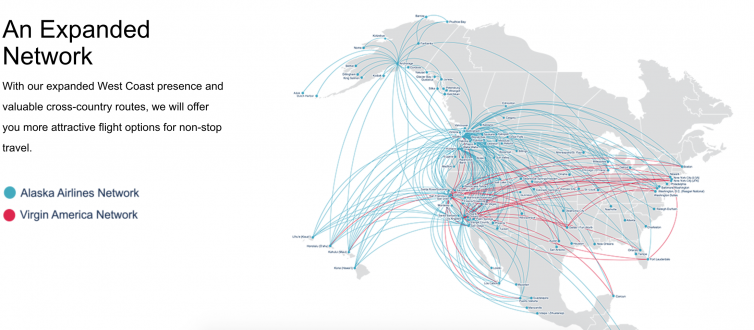
Virgin America and Alaska Airlines combined route network after the merger – Image: Alaska
An Expanded Route Network for Alaska Airlines
The addition of dozens of routes to the Alaska Airlines network appeared to cement Alaska’s stronghold in transcontinental flights ’“ at least temporarily. In subsequent years, many short-lived nonstop connections experienced a reduction in frequency or complete elimination from the timetable. Most notably, two major California markets ’“ San Francisco and San Diego ’“ have experienced the greatest reductions in service. Albuquerque and Kansas City, both destinations added to the Alaska network after the merger with Virgin America, will no longer receive service to San Francisco via Alaska Airlines. Four others ’“ Nashville, Baltimore, Philadelphia, and Raleigh/Durham ’“ have been reduced to seasonal summer-only service. Further south in San Diego, Alaska announced the removal of six nonstop destinations: Albequerque, El Paso, Kansas City, Minneapolis/St.Paul, Omaha, and St. Louis. In other locales, Reno to Boise and Burbank to San Jose in the Bay Area have also been eliminated entirely.
Despite the plethora of route reductions and elimination, Alaska remains in a positive growth trend. As Seattle experiences major congestion within its sole commercial airport, Alaska ventured north to Paine Field in Everett, Washington. Home of the Boeing Everett Factory ’“ the largest building in the world by total volume at over 13 million cubic meters ’“ Everett possessed the capacity and infrastructure to host commercial air service after Propeller Investments constructed a two-gate passenger terminal. On March 4, 2019, Alaska Airlines launched its first passenger flight from Paine Field; today, the airline operates nonstop service to eight destinations with planned service to two additional cities from the north Seattle suburb.
With the recent network changes, airport departure slots become unused and aircraft sit idle. With the intent to optimize available resources, Alaska increased service on transcontinental routes connecting San Francisco to Chicago and Anchorage, while simultaneously offering more daily departures between San Diego to Boston and Orlando. Alaska announced brand-new nonstop service from California to Redmond/Bend, Spokane, Missoula, and Boise. Served on E175 aircraft, Alaska Airlines finds itself in direct competition with regional carrier United Express and budget operator Allegiant Air.
BONUS: Flying the Alaska Airlines Embraer E175
History often repeats itself; if prior successes are any indication, the Chester logo will continue to thrive in the sky for decades to come.
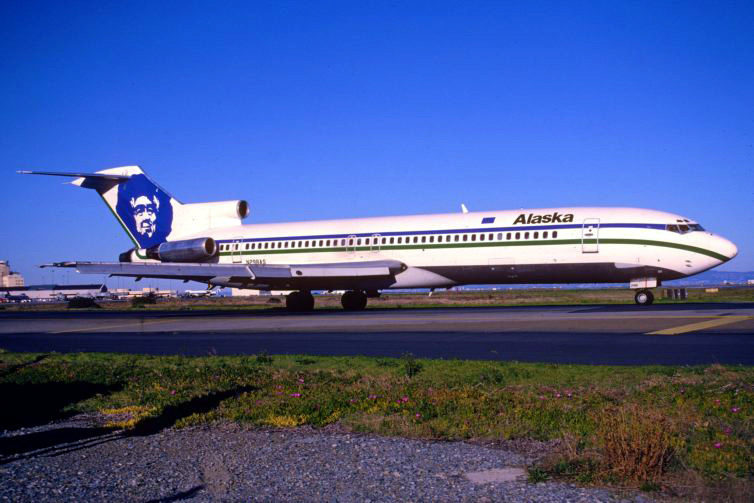
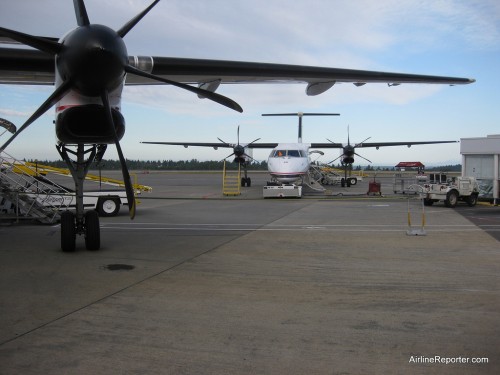
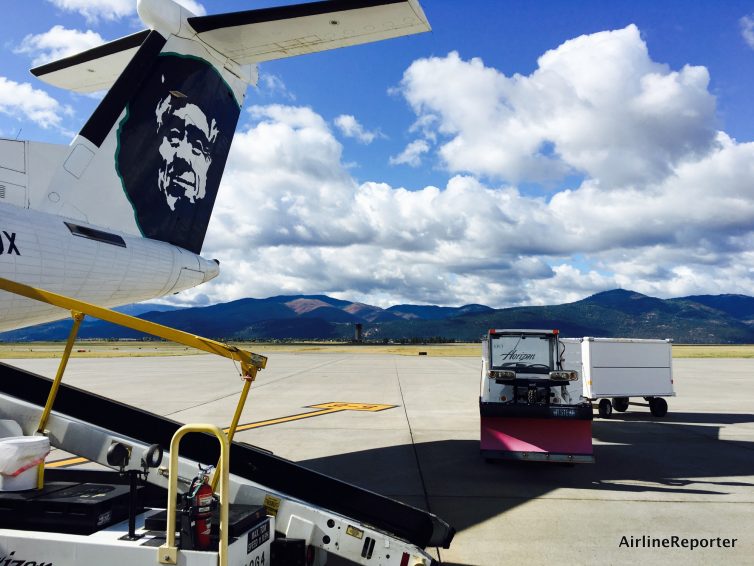
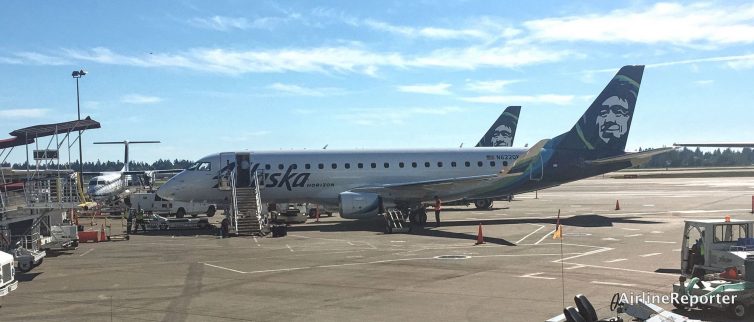
”Simultaneously, post-merger with Northwest, Delta began beefing up service to Seattle, elevating it to hub status in 2014. Continental ceased operations in 2012 after acquisition by United. Southwest merged with Orlando-based value-focused competitor AirTran. As a result, localized airline strongholds gave way to carriers with major hubs across the country; to maintain competitiveness, Alaska Airlines needed to acquire another carrier.”
Also of note is the fact that prior to these mergers, Alaska had partnerships with Northwest, Delta, and Continental; the loss of those strategic partnerships resulted in a significant shrinkage of the AS network.
A few notes:
– The cover photo is incorrectly dated – the Flickr page indicates it was taken in 1989.
– ”serving eastern seaboard destinations from Boston to Miami” – AS has not served Miami since 2012; VX never flew there.
– ”The Horizon Air brand has greatly matured since its Pacific Northwest beginnings, but the Horizon charm and feel remains consistent with its original model. Select complimentary alcoholic beverages are still served on all Horizon-branded flights, and its employees” passion for service lives on today.” – the phrasing of this is rather odd since as you note earlier, the Horizon brand has been retired; there are no Horizon-branded flights.
Hello Tonei,
Thank you for your feedback! Your notes are entirely correct; the cover image is in fact from 1989. AS served MIA beginning in 2002, later electing in 2012 to instead operate out of Ft. Lauderdale to the north of Miami. Alaska Airline’s loss of partnerships and positive relationships with other legacy carriers post-merger did lead to shrinkage in the route network; however, AS has bounced back well. Many routes – especially regional routes – may have experienced the greatest negative impact. Subsequently, the AS regional network has since expanded to new destinations across the country, something we may not have seen without the loss of these partnerships.
Spencer
Spencer,
Your statement about United acquiring Continental Airlines May not be totally accurate. If you follow the money trail you might find that it was Continental that acquired United Airlines. Continental had the newer planes and the money while United had the route structure.
Hey Paul –
You raise a valid argument regarding the United Continental merger; one sentence cannot cover the intricacies of the entire United-Continental merger. In reality, the acquisition process was much more complex. An entire series of articles can be written describing how these two carriers combined into one. You are entirely correct by asserting that the blanket statement of United acquiring Continental does not encompass the details and complete reality of the merger. Instead, the brief mention was used to demonstrate how many airlines grew immensely as a result of mergers, which somewhat forced Alaska Airlines to consider acquiring another carrier to maintain competitiveness.
Spencer
Spencer,
Since the United name survived it is easy to suspect the outcome was that United bought Continental. However the management of Continental immediately came over to run the joint company and the corporation name initially was United Continental Holdings listed in the stock exchange. Recently Continental was dropped from the stock listing.
I do agree with your referencing the consolidation of airlines.
The history piece on Alaska Airlines is a good article. Do you have inside knowledge about Alaska?
I am a retired Continental pilot so I have closely watched the details of the marriage of the two. Fortunately I retired in 2007 just before the merger of seniority lists.
Paul
I have flown on Alaska quite a few times, and I can see that the booming business is truly reflecting on the quality of service! I am quite impressed by it!
Thibault,
I couldn’t agree more! Alaska has spent years perfecting their business to become a really good airline!
If Alaska added service between MFR and OAK it would streamline a lot. The only non-stop is United from SFO, there’s a lot of Bay Area people living in the Rogue Valley now and Alaska connects them through PDX or SEA.
Hi Patrick,
You make an interesting point; Alaska only connects Medford to Seattle and Portland. It would be great for Medford passengers to arrive into OAK rather than SFO. However, I do not see Alaska opening a Bay Area – much less Oakland – to Medford route in the near future. According to 2018 DOT statistics, roughly 43 passengers flew per day each way between MFR and the San Francisco Metropolitan Area. However, this data only shows those passengers who originate in SFO and terminate in MFR. As United currently serves SFO-MFR nonstop once daily via a mainline 737 or A320 and up to three times daily on CRJ200s via SkyWest, I assume the majority of these passengers are connecting through SFO, as the number of daily flights greatly exceeds the local passenger demand. OAK has a significantly smaller number of connecting passengers compared to SFO; thus the demand of an OAK-MFR flight would be significantly lower. Furthermore, AS only operates flights to Seattle, Portland and four cities in Hawaii from OAK. It appears for enough demand to exist to operate the OAK-MFR route, a large majority of the passengers must be connecting from other areas of the country. Due to Alaska’s relatively small presence in OAK, few passengers connect through OAK via Alaska. Alaska recently announced multiple route closures from both SJC and SFO, so it appears Alaska is reducing Bay Area operations. Alaska added SFO-RDM not too long ago; perhaps MFR could follow if SFO-RDM is a success. I’ll keep my fingers crossed as I’d love to see it; however, I don’t believe there is currently enough demand for Alaska to succeed with a direct OAK-MFR flight.
Spencer
I think a part of the low SFO-MFR only numbers is the inconvenience of going to SFO vs OAK. The biggest hindrance to me flying is the cost. A flight from SFO to JFK is only $5 more than to MFR. If Alaska can fly every hour between SFO and LAX for $54 they could fill a 319 every day for the same price.
Alaska Airlines is a major American airline headquartered in SeaTac, Washington, within the Seattle metropolitan area of the state of Washington. It is the fifth largest airline in the United States when measured by fleet size, scheduled passengers carried, and number of destinations served.
Alaska Airlines is one of the best airlines in America. Alaska is known for its excellent services so far. I have recently Travelled with Alaska Airlines and they made my travel more easy and comfortable. I had my bookings through Airlines Reservations Flights portal and they offered me great deals of Alaska Airlines Reservations and their staff is also so co-operative.
Hellow. Whatever you have posted is absolutely correct. During the year of 2019, approximately 46.7 million passengers flown in Alaska Air which is almost 2% higher than the previous year figures. Furthermore, the performance of the airline enhanced 4.2%, on the other hand fuel prices dropped by 3.9%. These aspects have extended the growth of 2.3% in nonfuel expenses for 2019.
In case you’re trying to find more information on the AUL Extended Warranty Claims then you’ll visit the official website for an equivalent .
AUL car Warranty
AUL auto Warranty
Obviously, the auto business has improved before, yet Tesla, which was … is one of the players in the American auto guardian, American Glass Products Asahi Glass Co Ltd Central Glass Fayal Group Guardian Industries Corporation and more information for American guardian warranty services call us: – +1-833-831-9039
American auto guardian
American guardian warranty services
View client car shield reviews . Leave an audit and offer your involvement in the Contact For Support and CarShield. View client grumblings of CarShield, Contact For Support help settle questions with the administrations of … F. Client Reviews are not utilized in the computation of Contact For Support Rating. More information for carshield com then call us:- 1-877-393-3942
This is a nice post. I am a travel blogger. If you want to go anywhere around the world, so visit Airlines Gethuman and get vacation packages and cheap flights.
I really enjoyed over read your blog. Thanks for sharing.
The blog you provided is very informative and helpful. Thanks for such an amazing article. worth reading
You wrote such a nice blog here.
Really Thanks for Posting such an useful and informative stuff, keep on sharing such an useful and informative stuffBest SAP ABAP Training Institute in Bangalore